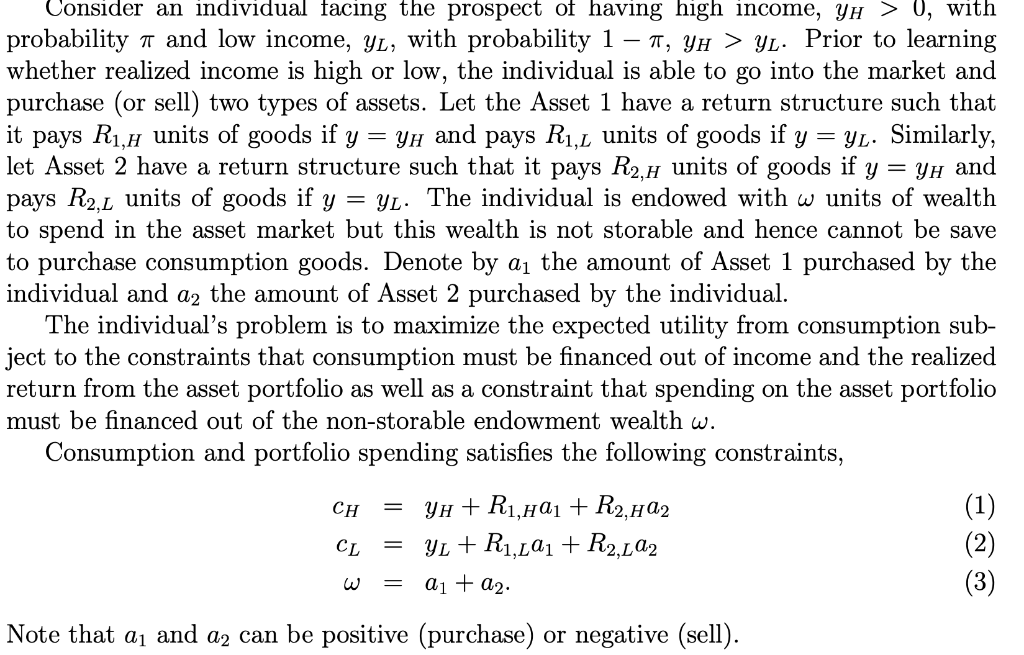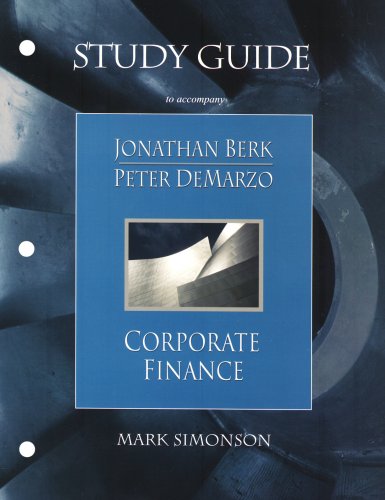

Consider an individual facing the prospect of having high income, yh > 0, with probability a and low income, yl, with probability 1 , yh > yl. Prior to learning whether realized income is high or low, the individual is able to go into the market and purchase (or sell) two types of assets. Let the Asset 1 have a return structure such that it pays R1,4 units of goods if y = yh and pays R1,1 units of goods if y=yl. Similarly, let Asset 2 have a return structure such that it pays R2,4 units of goods if y = yh and pays R2,1 units of goods if y = yl. The individual is endowed with w units of wealth to spend in the asset market but this wealth is not storable and hence cannot be save to purchase consumption goods. Denote by a the amount of Asset 1 purchased by the individual and a2 the amount of Asset 2 purchased by the individual. The individual's problem is to maximize the expected utility from consumption sub- ject to the constraints that consumption must be financed out of income and the realized return from the asset portfolio as well as a constraint that spending on the asset portfolio must be financed out of the non-storable endowment wealth w. Consumption and portfolio spending satisfies the following constraints, CH = CL = yh + R1,HQ1 + R2,HQ2 yl + R1,LQ1 + R2, L22 a1 + a2. (1) (2) (3) = Note that ay and a2 can be positive (purchase) or negative (sell). = = Suppose that (R1,_, R1,) = (1,0) and (R2,1, R2,H) (1,0) and (R2,1, R2,H) = (0,1). Again, illustrate the asset returns for each of the assets as a return vector. Show that sums of asset combinations can reach any point in the (R_, RH)-plane. What does this mean and relate it to our model of state-contingent claims? 7 Consider an individual facing the prospect of having high income, yh > 0, with probability a and low income, yl, with probability 1 , yh > yl. Prior to learning whether realized income is high or low, the individual is able to go into the market and purchase (or sell) two types of assets. Let the Asset 1 have a return structure such that it pays R1,4 units of goods if y = yh and pays R1,1 units of goods if y=yl. Similarly, let Asset 2 have a return structure such that it pays R2,4 units of goods if y = yh and pays R2,1 units of goods if y = yl. The individual is endowed with w units of wealth to spend in the asset market but this wealth is not storable and hence cannot be save to purchase consumption goods. Denote by a the amount of Asset 1 purchased by the individual and a2 the amount of Asset 2 purchased by the individual. The individual's problem is to maximize the expected utility from consumption sub- ject to the constraints that consumption must be financed out of income and the realized return from the asset portfolio as well as a constraint that spending on the asset portfolio must be financed out of the non-storable endowment wealth w. Consumption and portfolio spending satisfies the following constraints, CH = CL = yh + R1,HQ1 + R2,HQ2 yl + R1,LQ1 + R2, L22 a1 + a2. (1) (2) (3) = Note that ay and a2 can be positive (purchase) or negative (sell). = = Suppose that (R1,_, R1,) = (1,0) and (R2,1, R2,H) (1,0) and (R2,1, R2,H) = (0,1). Again, illustrate the asset returns for each of the assets as a return vector. Show that sums of asset combinations can reach any point in the (R_, RH)-plane. What does this mean and relate it to our model of state-contingent claims? 7








